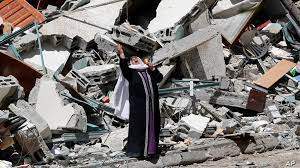Hamas-Israel Confrontation Sees Notable Differences from Past Fights

The Palestinian Hamas movement threatened Tuesday to redouble its rocket assault on Tel Aviv as Israel maintained its pounding of Gaza with airstrikes, dashing the hopes of US, Egyptian and Qatari mediators to pull off a ceasefire to end a confrontation that has seen both warring sides cross lines observed in previous duels.
Unrelenting Israeli airstrikes have killed scores of Palestinians, including at least 60 children, in the Gaza Strip since May 10. Israeli casualties have been much smaller — ten people, including a six-year-old boy, have been killed in Israeli towns and cities by rockets launched from Gaza. That’s largely thanks to Israel’s sophisticated anti-missile defense system.
The rapid outbreak of violence, which has now entered its second week, took many seasoned observers by surprise, although others say there were clear discernible factors leading up to the clash and that a heated confrontation was all but inevitable.
Hostility between Israel and the Gaza-based Islamist Hamas movement erupted into war in 2009, 2012 and 2014. But this latest clash of arms and is seeing some notable differences from past confrontations, say diplomats and observers.
First, Hamas has been ferociously attacking densely populated areas inside Israel, crossing a line by launching rockets on Jerusalem in addition to Tel Aviv and other major cities, according to Yossi Mekelberg, a research fellow at Britain’s Chatham House.
Hamas
Pushing the boundaries to target Jerusalem may be due to a shift in the balance of power within Hamas, suspect Western diplomats. They say there has been a widening split within the Hamas leadership between the movement’s political leader in Gaza, Yahya Sinwar, who favors pursuing diplomacy in a bid to secure a longer-term truce with Israel, and the military commander in Gaza Mohammed Deif. Along with Ismail Haniyeh, Hamas’s overall political leader based in Qatar, Deif has been an advocate of greater confrontation, diplomats say.
Likewise, Israel’s missile-barrage of the Gaza Strip has drawn widespread international condemnation for what some critics say has been a lack of restraint. Israeli forces have attacked 1,180 targets in the Gaza Strip, including on Saturday a tower block housing the offices of Al Jazeera and Associated Press as well as private apartments.
Britain has adopted a noticeably critical stance towards Israel. “We are deeply concerned by U.N. reports that 23 schools and 500 homes, as well as medical facilities and media offices, have been destroyed or damaged,” Prime Minister Boris Johnson’s spokesman said. “Israel must make every effort to avoid civilian casualties,” he added.
A second departure from previous confrontations between Hamas and Israel has been the communal violence within the borders of Israel between the country’s Arab citizens, who joined in protests last week against Israel on a scale not seen since 1948, and Israel’s Jewish citizens, notably militant settlers and far-right and Jewish settler groups. That has been an alarming new dimension, adding to an atmosphere of chaos, according to Shalom Lipner, an analyst at the Atlantic Council, a U.S. think tank, and a former adviser to seven consecutive Israeli prime ministers.
He says the communal clashes in mixed-population cities, including Lod, Jaffa and Acre, amount to “unprecedented domestic unrest” and risks “testing Israel’s fragile brand of coexistence to its limits.”
In a commentary for the Atlantic Council, he notes: “This negative trend comes on the heels of what was perceived widely as greater integration of Israeli Arabs into civic life. Allowing Hamas to drive a wedge between Arab and Jewish citizens of Israel would be a net loss to both groups,” he adds.
The future
Others think the communal unrest in Israeli cities largely last week may have longer term repercussions for the future shape of the state of Israel. Aaron David Miller, an analyst with the Carnegie Institute for International Peace, a Washington-based public policy research organization, has described it as “dismaying.”
“It went out of control of the Israeli government and that has to worry them,” he said.
The last time there was an outbreak of serious unrest among Israel’s 1.9 million Arab citizens was in October 2000, when Ariel Sharon, the late prime minister and then an opposition leader, marched under armed guard in Jerusalem from the al-Aqsa mosque, revered by Muslims, to Temple Mount, the holiest site of Judaism, to assert Jewish claims. But the violence was limited to Jerusalem and didn’t spread to other towns and cities, unlike this time.
Egypt’s diplomats who are trying to broker a ceasefire have told local media they believe they are close to persuading the warring sides to strike a truce, saying they hope to have struck a deal within two days. The chief of staff of Israel’s Defense Force, Aviv Kohavi, told local officials bordering the Gaza Strip that he suspects the fighting will continue for at least the next few days, but will continue “as long as it must.”
Source: https://www.voanews.com/middle-east/hamas-israel-confrontation-sees-notable-differences-past-fights




